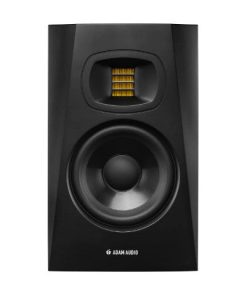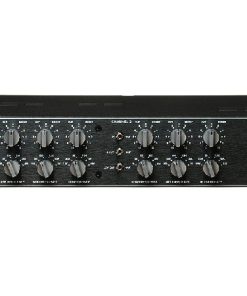SPL Phonitor 3 DAC SPL
$ 2.599,00 $ 649,75
The headphone amplifier, monitoring controller and DAC with 120V technology
Phonitor 3 DAC is not only the ultimate headphone amplifier and monitoring controller with 120V technology – the integrated DAC makes it the perfect monitoring centerpiece for demanding producers as well as sound and mastering engineers working with digital sources or in the DAW.
Whether if USB, AES/EBU or S/PDIF – the integrated DAC with analog SLP120 converts digital PCM audio signals with a resolution of 32 bit and a sampling rate of up to 768 kHz. It converts DSD signals with a resolution of up to DSD256.
On the analog side, the Phonitor 3 DAC, based on the SPL 120V technology, offers the same monitoring quality as the big SPL mastering consoles – on loudspeakers and headphones.
The analog Phonitor Matrix allows mixing and mastering on headphones in the highest quality – with the same spatial perception of the stereo stage as on loudspeakers.
Great sound – for headphones
The Phonitor 3 DAC offers connection for a standard headphone with a stereo jack plug on the front. Thanks to the enormous output power, all kind of headphones are driven effortlessly. Thus, it plays out the advantages of the SPL 120V technology and rewards the listener with an honest, detailed and at the same time vivid sound experience.
Great sound – also for loudspeakers
On the rear of the device, Phonitor 3 DAC offers a stereo output which makes it a high-quality monitoring controller for any monitoring situation. Active speakers with an integrated power amplifier or passive speakers in combination with a power amplifier can be connected at this output.
Monitoring at the highest level
Phonitor 3 DAC offers the same key technology – SPL 120V technology – and signal quality as the big SPL DMC and MMC mastering consoles.
Headphones or Speakers
The Output switch – simply switch from headphone to speaker playback. In the center position (Mute), no signal reaches the outputs. The VU meters light up red.
Digital & analog stereo inputs – free choice
Up to six stereo sources can be connected to the Phonitor 3 DAC.
The source is selected via the Source switch.
Analog inputs
On the analog side, two analog stereo inputs are offered, each with two XLR line inputs. Professional analog players with balanced outputs and line level can be connected here.
Digital inputs
On the digital side, the Phonitor 3 DAC offers four digital stereo inputs.
USB
The USB input (type B) can be used to directly connect the DAW. No driver installation is required for operation with a Mac or an iDevice. Via USB, the Phonitor 3 DAC converts PCM audio signals with a resolution of 32 bits and a sampling rate of up to 768 kHz as well as DSD signals with a resolution of up to DSD256.
S/PDIF, coaxial
The Input S/PDIF coaxial can also receive a two-channel signal (PCM audio) with sampling rates up to 192 kHz and a bit rate of 16 bits to 24 bits. Unbalanced, 2-wire 75-ohm coaxial cables with RCA connectors are used for signal transmission.
S/PDIF, optical
The S/PDIF optical input can also receive a two-channel signal (PCM audio) with sampling rates of up to 192 kHz and a bit rate of 16 bit to 24 bit. The input jack is an F05 jack. This interface is better known under the Toshiba brand name TOSLINK.
Tip: You should attach importance to the quality of the optical fiber. With inexpensive plastic optical fibers, transmissions with quad sampling rates (176.4kHz/192kHz) may have faults. In this case a glass fiber optic cable should be chosen.
AES/EBU
The AES input provides an input jack which corresponds to a standard XLR input (XLR, female). An AES signal can transport two encoded PCM audio channels with a maximum sampling rate of 192 kHz and a bit rate of 16 bits to 24 bits. This standard is defined under IEC 60958 Type I. Balanced, 3-core, 110 Ohm “twisted pair” cables with XLR plugs are used for connection.
The DAC – the best is just good enough
The converter chip in the Phonitor 3 DAC´s digital-to-analog converter is the highly acclaimed AKM AK4490 Velvet Sound™ premium DAC chip, which thanks to its architecture reproduces the finest sound details. It converts PCM audio at 32-bit resolution and a sampling rate of up to 768 kHz, which is 16 times the resolution of a CD. Direct Stream Digital is also supported up to a resolution of DSD4 or DSD256.
SLP120
The analog output of any DAC chip must be filtered by a low pass filter when entering the analog world. In contrast to all other DACs in the world, the low pass filters here are built using SPL 120V technology, which provides a plus in dynamics and headroom and sound. The DAC in the Phonitor 3 DAC is equipped with the SLP120 – an analog “single low pass” filter with 120V technology.
Milled from solid
The massive 45mm volume control knob milled from aluminum is a haptic highlight. Its mass together with the Alps RK27 “Big Blue” potentiometer enhances the “spoon in the honey” feeling even further and provides perfect control of the monitoring level.
Monitoring without any compromises
The Phonitor 3 DAC is a full-fledged
monitor controller:
- Source selection
- Phonitor Matrix with Crossfeed, Speaker Angle and Center Level (the latter can be switched off)
- Mono/Stereo
- Laterality control
- Solo L/R
- Phase inversion for L and R
- L/R Swap
- Output switchable to headphones or speakers
- Mute
Mono or stereo – a matter of setting
The Mono/Stereo switch can be used to select whether the output signal of the Phonitor 3 DAC is a regular stereo signal or whether it is summed to a mono signal.
Finding the real center
Naturally, hearing can be directed more to the left or more to the right.
This becomes particularly clear when listening on headphones.
Therefore, the Phonitor 3 DAC has the uniquely finely resolved laterality control, which rebalances the stereo image on the monitoring side.
The Mono/Stereo switch can not only be used to switch between stereo or mono playback. This switch is also used to activate or deactivate the laterality control.
Solo L/R
Only the right or left channel of the audio signal should be played back?
The Solo L/R function makes it possible. If the triple selection switch is
in the “L” position, only the left channel is played back – if it is in the “R” position, only the right channel is played back. In the middle position “Off” the Solo function is switched off. The regular stereo signal consisting of the left and right channel is thus present at the output of the Phonitor 3 DAC.
L/R Swap
A special feature is the channel swap function: L/R Swap.
This function inverts the stereo image. Left becomes right and right
becomes left. This is especially important and extremely time-saving, when you are monitoring samples in video dubbing that should match a scene with direction of movement. If the direction is not correct, you usually have to load the sample into the DAW to switch channels. before you can judge whether the sample matches the image. With the L/R Swap function, this is no longer necessary. You can now adjust the direction of movement on the Phonitor 3 DAC while pre-listening the sample library.
Phase inversion for L and R
With this switch the phase of the left or right channel of the audio signal can be inverted. If the three-way selection switch is in the “L” position, the left channel is inverted – if it is in the “R” position, the right channel is inverted. In the middle position “Off” this function is switched off. At the output of the Phonitor 3 DAC the regular stereo signal is thus present.
M/S – Mid or Side?
By using the mono/stereo and L/R phase inversion switch in combination, it is also possible to only monitor the mid or side signal. When the switch is set to “Mono” and phase inversion is active for L (or R), only the side signal is played back.
If the phase inversion is switched off, the mono signal corresponding to the “M” signal is played back. Separate monitoring of the M and S signals has become a widespread standard for many mixing and mastering engineers.
Everything at a glance
Two mechanical VU meters visualize the input levels for the left and right audio channels.
The “VU Cal” switch can be used to reduce the signal visualized on the VU meters by -6 dB or -12 dB.
Thus, the VU meters operate in the ideal display range even at very high input levels.
The Revolution: Phonitor Matrix
The Phonitor Matrix is the revolution in the headphone amplifier.
One of the unique features of SPL headphone amplifiers is the SPL Phonitor Matrix. It enables mixing and mastering engineers to create perfect mixes on headphones, which will translate perfectly to all types of stereo speaker systems.
But the Phonitor Matrix is not only designed for professional use in the studio. It also enables the hifi enthusiast to enjoy music on headphones, like if it was played back on speakers.
How is this possible?
Music is normally produced and mixed for playback on stereo speakers.
Listening on headphones is different from listening on loudspeakers. The biggest difference is the lack of crossing signals of the sound signal from the left speaker to the right ear and from the right speaker to the left ear.
These crossing signals are missing in conventional headphone listening, because there are no signals crossing from one side of the headphones to the other. This results in an unnaturally wide stereo stage and sound sources are not played back at their actual position in the stereo spectrum.
The SPL Phonitor Matrix can correct this false stereo image with an analog circuitry.
| Options | Phonitor 3 DAC, Phonitor 3 DAC + Expansion Rack |
|---|
Prompt Delivery and Professional Packaging
Our long-standing partnership with UPS FedEx DHL and other global carriers lets us offer a range of shipping services. Our warehouse staff is extremely skilled and will package your items according to our precise and exact specifications. Your goods will undergo an extensive inspection and be safely packaged prior to being sent out. Each day, we ship to thousands of customers in many countries. The fact that we are committed to becoming the biggest online retailer in the World is clear. These warehouses are in Europe in the same way as they are in USA.
Note: Orders that include more than one item are assigned a processing period depending on the item.
Before shipping, we will inspect thoroughly the items you have ordered. Most orders are shipped within 48 hours. Expected delivery time is between 3-7 days.
Returns
Stock is dynamic. It's not entirely managed by us since we are involved with multiple entities, including the factory and the storage. The actual stock can change at any moment. It is possible that your order may be out of stock once the order has been placed.
Our policy lasts for 30 days. We cannot exchange or refund your order if it has been 30 days from the date of purchase.
For your item to be returned it must be in its original packaging, unopened and in the condition you received it. The item must be in its original packaging.
Related products
Microphones
Accessories
Recording Equipments
Subwoofer
Microphones
Recording Equipments
Recording Equipments
Monitor
Monitor Systems
Subwoofer
Monitor
Microphones
Recording Equipments
Accessories
Headphones
Equalizers
Monitor
Monitor Systems
Accessories
Recording Equipments
Accessories
Equalizers
Monitor
Monitor






























































